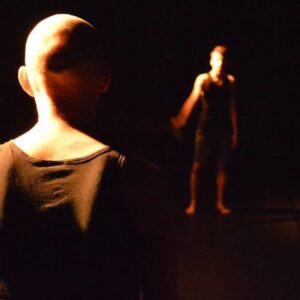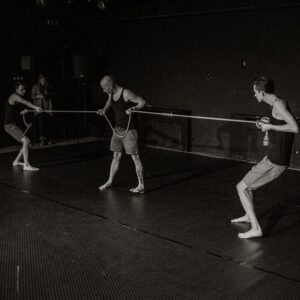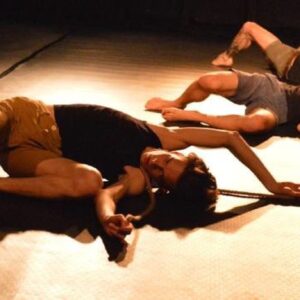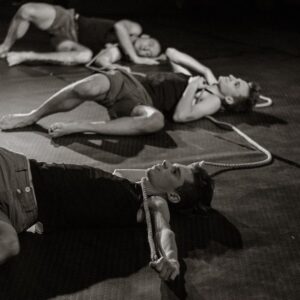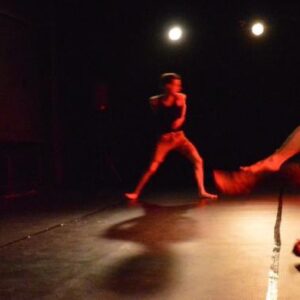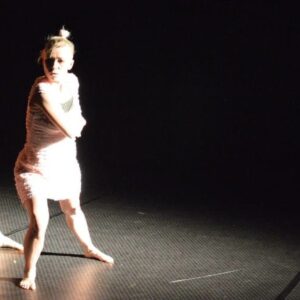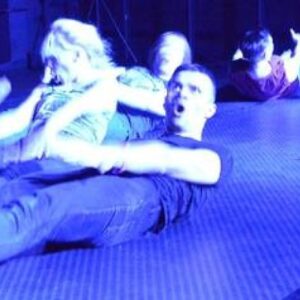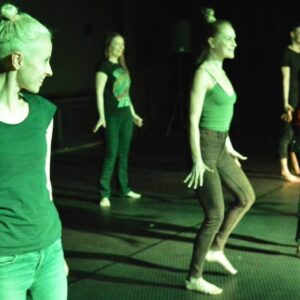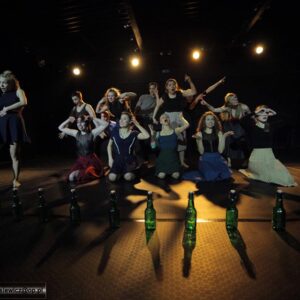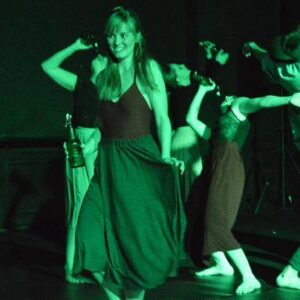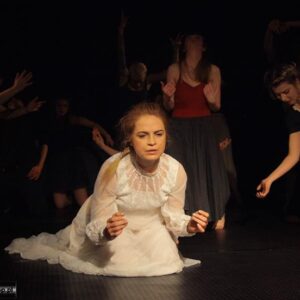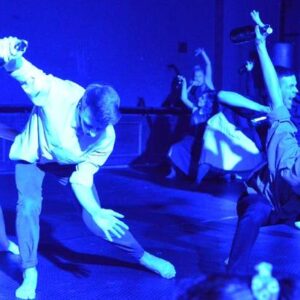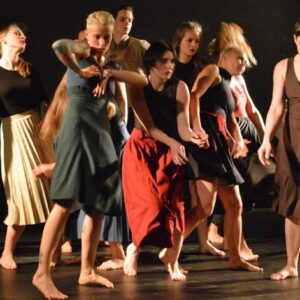From passion to magic
5 years of the Dance Theater Studio: Zielona Góra, 2016-02-26 - 2016-02-28
Five years ago, at the Youth Center for Culture and Education in Zielona Góra, choreographer and dance theorist, Dr. Marek Zadłużny, opened a Dance Theater Studio. Full of passion and fascination with the possibilities offered by a creative act on the border of two plays, he did not choose to work with professional actors or dancers who had years of courses or tournament struggles behind him. What mattered was sensitivity, imagination, the ability to work hard and sacrifice, and above all, a true love of dance. Five years, a few hundred hours in dance halls and a dozen or so premieres later, on the stage of the Department of Culture Animation and Andragogy of the University of Zielona Góra, we watch a group of separate artists, creating in a unique aesthetic that cannot be forgotten or attributed to anyone else.
Last weekend, on the occasion of its fifth birthday, Pracownia Teatr Teatr Tańca organized a review in Zielona Góra, during which it presented four premiere performances. As part of the network cooperation under the slogan "Sfera Ruchu", she also invited her friends to joint celebrations of the jubilee: Akro Dance Theater from Toruń, Terminus A Quo from Nowa Soli and Enza Dance Theater from Słupsk, as well as instructors Jacek Niepsujewicz and Marta Pelińska, who conducted workshops for dancers.
The curse of manhood
The review opened with the performance "# 4", based on the solo choreography by Paweł Matyasik, entitled "Short days". The dancers (Marek Zadłużny, Radosław Bajon and Gabriel Zaborniak) took up the topic of the formation of male identity, telling about the rite of passing into adulthood of four adolescent boys who try to meet social expectations and prove that they are real men. The arrangement begins with choreographic images of the characters jumping rope in turn and trying their hand at tugging the rope. Instead of the element of fun, however, they are accompanied by tension and competition. Under the guise of joyful backyard games, there are the first challenges and masculinity tests that boys have been subjected to since childhood. At this stage, testosterone levels are mainly measured through the prism of physical fitness.The boys, however, already sense the coming change. The movements of the dancers, writhing on the floor like worms and lying on their side with invisible cigarettes in their hands, form a sequence that makes them look like Mr. Caterpillars from "Alice in Wonderland". Just like he, they expect transformation - turning into a butterfly and abandoning infantile mockups ( such as chewing gum in cigarette papers or water pipes loaded with fruit molasses) for "true male attributes" such as cigarettes. Soon after, the characters are teenagers, and their image of the male world becomes more and more complicated. They are being shaped by films about the Wild West or gangsters - "The Good, the Bad and the Ugly", "The Godfather" or "Pulp Fiction". The dancers aim at each other with imaginary guns.Ultimately, however, this attempt ceases to be a sufficient challenge for them. So they redirect the barrels of their weapons, aiming at their own temples and - like in "Deer Hunters" - they try to withstand their opponents by checking who is the first to chicken. The game of Russian roulette ends with a symbolic death, which turns out to be the transition to adulthood.
The presentation of adulthood as an introduction to dying has its source in many texts of pop culture - for example in the famous song by Hey "Adulthood as the beginning of dying". In the vast majority of cases, however, this issue is presented from the position of a woman. In "# 4" this perspective is changed, thanks to which the creators manage to escape from well-worn patterns and show the complexity of the issue. In their performance, men are tormented by the "every fear of humanity" described in the aforementioned song, an internal worm from which there is no escape. It is worth noting that this subject is explored to some extent by "The Suicide Room". This is probably why one of the key scenes of the performance features the song "Turn me on", popularized by the film.The adult heroes dance with her on the dance floor with a victoriously displayed - at last real - cigarette in hand, adjusting to the next "norms" according to which (as Fisz would say) "boys go to the club polished up on girls". In the end, however, all these social mouths turn out to be hard to bear, which each dancer manifests in a different way.
The strength of the performance - apart from the elaborated architecture of the arrangement, the subtlety of the gesture, far from the exaggerated style of silent films, with the help of which the gender identity of the characters is usually emphasized and the combination of meticulous virtuosity with dancing freedom - is primarily the fact that he does not resort to a simple definition of masculinity . By negating the stereotypical images revolving around physical condition, objects, roles and attitudes, she leaves viewers with questions that they will certainly come back to. By showing that being a man can be a curse, it also becomes an important voice in a current (sic!) Discussion about the crisis of masculinity.
Lonely she-wolves
During the jubilee of Pracownia Teatr Tańca, a short performance, partly based on improvisation, "Wolves Return", was also presented by two dancers - Agnieszka Jodłowska and Kalina Grupa. Wild Woman, based on the assumption that women and wolves are similar. Jodłowska and the Group used dance as a universal language enabling them to give voice to this inner she-wolf, which lurks somewhere deep in the consciousness of women, although they do not respond to its exteriors on a daily basis. Thanks to improvisation, which enables them to follow the instinct, subtle hypnotic movements and the inner the dialogue they clearly had with each other during the dance allowed their primal nature to speak,who is both wild and courageous and caring.
Love as a viral disease for which there is no vaccine
Recently, scientists were able to confirm that a man in love activates the same brain centers as in a drug addict, thanks to which they could classify love as a disease entity. The new controversial theory was reflected in the comedy performance of Pracownia "LOVEsongs", comparing lovers to madmen. The performance was prepared and performed by eight dancers (Justyna Śmietańska, Agnieszka Jodłowska, Marta Pelińska, Katarzyna Pawlak, Kalina Grupa, Łukasz Szpajny, and Marek Zadłużny), and Marek Zadłużny. it is divided into several parts, emphasized by an ingenious composition. Each of the stages begins and ends with the passage of the dancers between two screens placed on opposite sides of the stage.what is announced by the accompanying songs and the statements emitted by the loudspeakers and fragments of texts about this feeling. The dancers go on a short journey through love hits, such as "Hello, I love you" by The Doors and popular themes - including mermaids. the sailors of the magic creatures of the "Odyssey". Instead of Werters who are mad with love, it shows zombies, taken straight out of American B-class horror films. Comic gestures and expressions of the dancers repeatedly caused a storm of laughter and applause in the audience, and the culminating moment when, resembling sirens, they jumped like fish pulled on the sand, he amused the audience to tears.The dancers go on a short journey through love hits, such as "Hello, I love you" by The Doors and popular themes - including mermaids. The play, kept in a humorous convention, tells more about city mermaids from Artur Rojek's song than about attractors the sailors of the magic creatures of the "Odyssey". Instead of Werters who are mad with love, it shows zombies, taken straight out of American B-class horror films. Comic gestures and expressions of the dancers repeatedly caused a storm of laughter and applause in the audience, and the culminating moment when, resembling sirens, they jumped like fish pulled on the sand, he amused the audience to tears.The dancers go on a short journey through love hits, such as "Hello, I love you" by The Doors and popular themes - including mermaids. The play, kept in a humorous convention, tells more about city mermaids from Artur Rojek's song than about attractors the sailors of the magic creatures of the "Odyssey". Instead of Werters who are mad with love, it shows zombies, taken straight out of American B-class horror films. Comic gestures and expressions of the dancers repeatedly caused a storm of laughter and applause in the audience, and the culminating moment when, resembling sirens, they jumped like fish pulled on the sand, he amused the audience to tears.The playful convention, however, tells more about the city mermaids from Artur Rojek's song than about the magic creatures from "The Odyssey". once they caused a storm of laughter and applause in the audience, and the culminating moment, when resembling mermaids, jumping like fish stretched out on the sand, amused the audience to tears.The playful convention, however, tells more about the city mermaids from Artur Rojek's song than about the magic beings of "Odyssey" that attract sailors. Instead of the Werters who are mad with love, it shows zombies, straight from American B-class horror films. Comic gestures and dancers' faces over and over again once they caused a storm of laughter and applause in the audience, and the culminating moment, when resembling mermaids, jumping like fish stretched out on the sand, amused the audience to tears.they jumped like fish stretched out on the sand, he amused the audience to tears.they jumped like fish stretched out on the sand, he amused the audience to tears.
It is worth noting that "LOVEsongs" is a spectacle that, in a comedy form, smuggles a lot of universal truth about love. As a walk through all its shades, it refers to the personal experiences of the audience and evokes memories of behaviors which - from the perspective of time and mind freed from excess dopamine - they often regret it, which is certainly why a part of the audience was strongly moved by his message, and the performance itself was received with the warmest reception among all the performances presented on the first day of the review.
White carrying emptiness
The end of the second day of the jubilee celebrations was graced by the Dance Theater Studio with the performance "Ederlezi" prepared according to the choreography by Marek Zadłużny and directed in cooperation with Małgorzata Kazińska. extended to the story of the bride waiting in vain among the wedding guests for her bridegroom. Just before the show, many viewers were of the opinion that a reference to such a limited theme would close the performers within tight conventions. They expected to see dancers on stage performing an oro dance in gypsy costumes and flower wreaths. The team of Pracownia surprised them with a fresh approach based on the clash of tradition and modernity.The performance begins with a modern bottle dance performed by an unusually large, thirteen-person team of wedding guests (composed of almost all members of the Studio). The monumentality of this picture, combined with disturbing music, builds strong tension. Despite the fact that the dancers spin, cutting the space with sudden movements and freezing in symbolic toasts, the audience cannot indulge in the idyllic atmosphere with which the holiday of spring is associated. The scene of the bride's arrival, who suddenly realizes that the whiteness of her wedding dress can only bring emptiness to her and decides to take it off, takes on a unique drama. All the more so because unlike the guests full of energy, who loudly express their emotions, the bride remains a static figure and her complaint is silent.
The premiere performances of Pracownia Teatr Tańca were combined with excitement, dynamics, focus on conveying important content and - most importantly - the characteristic aesthetics of dance theater, physical theater and contemporary dance. The way they interacted with each other became - apart from numerous awards - another proof that the dancers made good use of the five years together. The faithful viewers and fans of the team from Zielona Góra are certainly looking forward to the next jubilee. Those who would like to stop at the last weekend and reminisce are invited to the second report from the review.
Agnieszka Moroz
The Theater Journal
March 4, 2016

